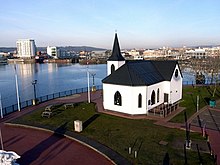Norwegian Church, Cardiff
| Norwegian Church | |
|---|---|
 |
|
| 51°27′41″N 3°09′43″W / 51.46143°N 3.16192°WCoordinates: 51°27′41″N 3°09′43″W / 51.46143°N 3.16192°W |
The Norwegian Church Arts Centre is a point of cultural and historical interest located in Cardiff Bay (Tiger Bay), Wales. It was a Lutheran Church, consecrated in 1868. Under the patronage of The Norwegian Seamen's Mission provided home comforts, communication with family and a place of worship for Scandinavian sailors and the Norwegian community in Cardiff for over a hundred years.
In the 19th century, Cardiff was one of Britain's three major ports, along with London and Liverpool. The Norwegian merchant fleet at the time was the third largest in the world, and Cardiff became one of the major centres of its operations.
Sjømannskirken – the Norwegian Church Abroad organisation, which is part of the Church of Norway – followed in its footsteps. Under Carl Herman Lund from Oslo, a Church was built in 1868 in Cardiff Bay between the East and West Docks on land donated by the Marquis of Bute, to serve the religious needs of Norwegian sailors and expatriates.
Consecrated in December 1868, the church was clad in iron sheets on the instruction of the harbourmaster, to allow it to be moved if necessary. However, the construction form allowed it to be extended many times:
Known until this point as the Norwegian Iron Church, it now became known as the Little White Church, and became a welcome home point for sailors. Resultantly, and open to all sailors as a mission offering food and shelter, between 1867 and 1915 the number of visiting sailors to the church rose from 7,572 to 73,580 seamen per annum.
When the church was in its prime it had a lot of public activity; from the Nordic community settling in Cardiff and making roots there, to the Norwegian sailors using the place as a rest stop on their travels. The church had become a home away from home for the sailors during World War II as they weren't able to go back to Norway due to Nazi occupation. The church hosted many important family occasions, such as weddings and christenings, for the community as well as more educational projects like cookery classes.
...
Wikipedia

